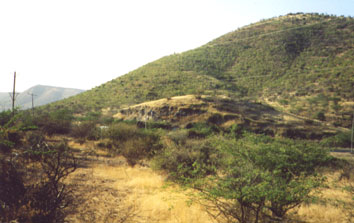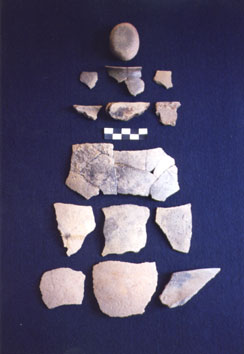The Bellary District Archaeological
Project

|
The Bellary District Archaeological Project |
 |
| Re-investigating Kudatini Ashmound |
Working at the Kudatini ashmound (see Geoarchaeology of ashmounds) presented the opportunity for the team to explore the area around the ashmound for signs of activity and habitation. In particular, exposures of long sections as a result of trench-digging to the north of the ashmound by the Public Works department provided the opportunity to see 'below the surface' at Kudatini, where little cultural material has come to light in previous surface explorations. Finds of cultural material were made at several locations along the trenches. In particular, Neolithic material consisting of pot sherds (including a number from several very large vessels), a rubber stone and burnt and unburnt animal bone (including cattle) was found within an exposed pit which was covered with a large, flat shale stone (see photo lower right). No habitation deposits were identified in section, though material removed by animal burrowing at nearby locations contained low densities of habitation material, suggesting that pockets of light habitation deposits might be preserved to the north of the ashmound. Numerous rubber stones and small querns were also located in the area around the ashmound, suggesting the processing of food grains was carried out at the site. The findings are consistent with a scenario of occasional encampment and possible feasting activity at the site, though they by no means suggest longer term habitation of the kind suggested by Paddayya (1991-2), as Korisettar and colleagues (2001) argue in a recent paper. |

Kudatini ashmound 
Neolithic material found in exposed pit at Kudatini |
|||

|

|
| Research:
Archaeological Background, Introduction
to Project, Intensive Systematic Survey,
Geoarchaeology of Ashmounds, Archaeobotany and Agriculture, ..Re-investigating
Kudatini Ashmound, Sarcophagus
Burial at Kudatini, Rock Art, Landscape
and Cosmology, References. Other
Information: Training, Protection
of Sites and Monuments, .Conferences,..Future Prospects,
Project Team, Publications, Web Links, Funding
& Acknowledgments
|